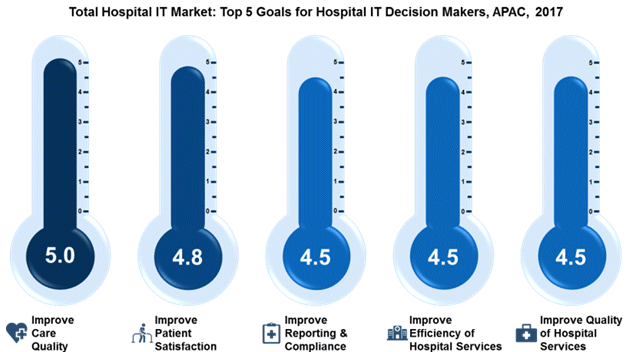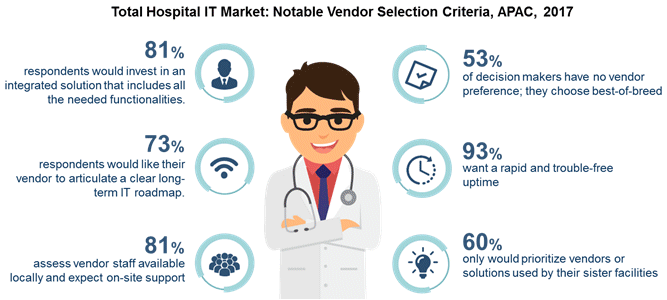By Natasha Gulati, Industry Manager, Digital Health

Asia-Pacific (APAC) is the fastest growing market for hospital information technology (hospital IT) solutions globally, and is expected to generate over $15 billion in revenue by the end of 2021. However, promising numbers betray the tidal wave of challenges that lie ahead for vendors trying to penetrate and succeed in the market. Not too long ago, Hospital IT in APAC was dominated by siloed technology investments achieving basic automation and digitalization. Today, healthcare service providers are progressively moving from Return-on-Investment to “Value-of-Investment” or VOI when measuring the success of their IT department. The demand for VOI summarizes the following emerging customer needs/ expectations that have surfaced only in the last two years in APAC:
- Future-focused IT investments and vendor relations
- Workforce empowerment through technology
- Monetization of the IT department
Frost & Sullivan conducted a region-wide survey in the first quarter of 2017 covering IT decision makers, including C-suite members, clinical and administrative department heads, and IT directors or champions across public and private hospitals in APAC. The key goal of the survey was to identify unmet customer needs in the hospital IT market and predict the direction of IT evolution across the region. The survey gathered 73 responses with representation from Australia, China, Japan, India, Southeast Asia, and South Korea.
Health and wellness consumers in APAC, influenced by increasing technology adoption, rise of medical tourism and growing education and awareness, are demanding greater control and involvement from care providers. As a result, the shift toward patient-centricity is becoming truly tangible as providers have started designing hospital infrastructure, workflows and care teams keeping the patient in mind. Achieving patient-centricity and better patient engagement and experience requires hospitals to redesign their technology ecosystem keeping VOI in mind.
Future-Focused IT Investments and Vendor Relations
Traditionally, hospital IT infrastructure in APAC has been built one department at a time. As a result, providers face a whole gamut of issues including poor integration and interoperability; lack of solution flexibility and scalability; vendor dependence, and inadequate solution customization. About 44% of respondents stated that the lack of a long-term IT roadmap has been a high or crippling challenge for their organization. IT systems do not match actual hospital workflows, thus becoming a hurdle for

clinicians rather than a solution. Expensive legacy architecture takes time and resources for upgrades as vendors and solutions are not interoperable. Therefore, 73% of hospital IT decision makers in APAC expect their vendor to articulate a clear long-term solution road-map. Over 80% of respondents prefer to invest in end-to-end solutions that would address multiple needs across a specific workflow or for a department.
Workforce Empowerment through Technology
Despite deploying well-planned IT solutions, actual adoption and usage remain low mainly because they disrupt existing workflows. Human inertia was identified as a key organizational challenge by a staggering 98% of the respondents. Lack of skills development and training of the medical workforce are only a part of the problem; respondents reported shortage of IT staff and insufficient and/or untimely vendor support as other issues. Hospital IT decision makers now understand that organizational staff is an asset that needs to be empowered through technology, not replaced. About 60% of respondents reported improving internal communication and collaboration a key goal within their organization. Better communication is expected to improve both quality and efficiency of care. Hospitals are increasingly involving care teams in IT business analysis so that solutions are designed keeping the end-user in mind.

Local support staff and availability of field support are basic vendor expectations and also the key drivers for multinational vendors to either partner with local players or invest in on-the-ground presence so that they can improve market penetration.
Monetization of the IT Department
Budget constraints for IT are an old fable. Hospital IT decision makers want to enable an industry-wide change by turning the IT department from a cost-center to a revenue generator. Creating and nourishing new revenue streams was a key goal for 45% of the respondents. Commercialization of solutions developed by the hospital is an approach gaining momentum.
Simultaneously, providers are also seeking out approaches to make the IT department more specialized as well as more productive so that they are less dependent on the vendor. In response, most IT vendors are exploring professional consulting and business intelligence services as alternative revenue models that could potentially include business performance indicators to measure the success of the partnership between hospitals and IT companies. Joint ventures and industry partnerships that allow hospitals to leverage vendor technologies, R&D teams and branding to commercialize co-developed solutions are becoming an attractive option for introducing sophisticated solutions as well as driving market penetration for both parties.
These transformational shifts in consumer needs require vendors to rethink their solution strategy, contract design and evolution to a services-based business model. Emerging technologies such as cloud-based solutions and Big Data Analytics can help address many of these issues. Cloud solutions are helping providers optimize infrastructure spending and IT resources, while analytics are helping them dissect organizational data to identify workflow and employee inefficiencies as well as potential solutions for them.
The most breakthrough market shift that can be seen is a redefinition of vendor contracts where vendors are currently expected to act as business partners and share risk. An increasing number of providers are expecting contracts where vendors offer technical and business resources to help providers develop new solutions and take them to successful commercialization. Vendors have also started basing contract terms on achievement of listed business key performance indicators.
Dollar returns on IT are a microscopic view of the hospital IT market. Information technology serves multiple purposes beyond automation. These include higher employee productivity, positive patient outcomes and satisfaction, and creation of a digital ecosystem that increases stakeholder value through more than just increasing revenue. To achieve these goals a close partnership with vendors is essential and APAC is ready to move in this new direction. The first step is to enable open innovation platforms both from a technology and a contractual standpoint that enable hospitals to design an IT architecture that matures with their organization. Vendors who can bring this value proposition to the table stand a promising chance to succeed in this market.
Register for the Frost & Sullivan webinar, “Beyond Superior Care Quality – How Can APAC Hospitals Become Truly Patient Centric”
To learn more about Frost & Sullivan’s Digital Health program please CLICK HERE
Contact us to discuss how Frost & Sullivan can help you in your journey in digital healthcare
Natasha Gulati, Industry Manager – Digital Health, Asia Pacific [email protected]
Daniel Ruppar, Research Director – Digital Health, Global [email protected]



